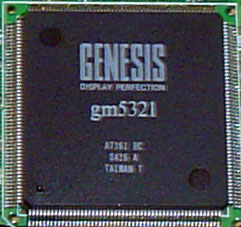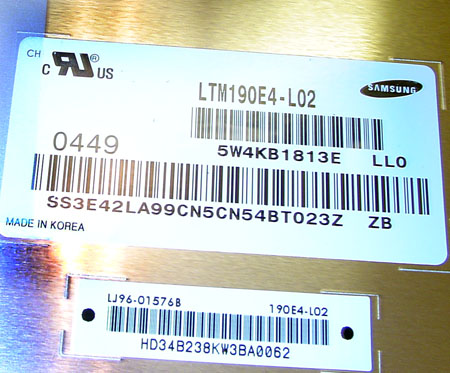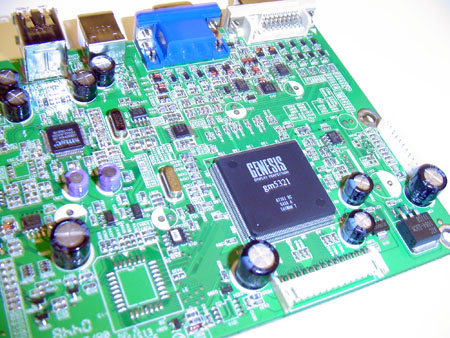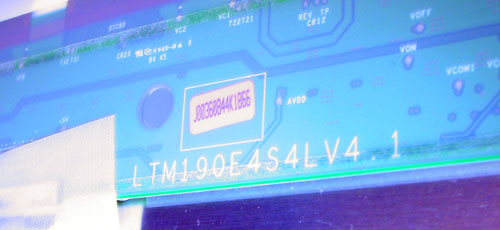Dell UltraSharp 1905FP: Setting the Bar for New 19" LCDs
by Kristopher Kubicki on January 29, 2005 12:35 AM EST- Posted in
- Displays
Genesis gm5321
At the heart of every good LCD monitor revolves around a great signal processor – and our Dell 1905FP is no exception. The Genesis gm5321 found in the Dell 1905FP acts as the unified analog and digital controller for everything on the monitor except sound and USB. According to the technical documentation, the Genesis gm5321 is HDCP capable – so you should be able to hook up a DVI-HDCP receiver or DVD player to the monitor without worries.

Our monitor did not come with any sound capability, so that controller does not exist on the PCB. In the upper left corner of the board, you can see the SMC USB controller.
The ribbon connector just below the Genesis DSP provides the input for the LCD panel while power from the separate inverter comes across the plug along the right side of the board.
Samsung LTM190E4
The cornerstone of our Dell 1905FP is the superb Samsung LTM190E4 panel.

Interestingly enough, after opening the monitor, some of the modulation PCB from the panel was directly exposed, but sheathed in a protective film. The components of an LCD panel are almost always sheathed behind metal EMI shields.
The Samsung website currently advertises a 1000:1 contrast ratio for the panel, which is probably a little too inflated. The original Samsung 193P used the same panel, but only advertised an 800:1 contrast ratio, and Dell advertises the 1905FP with an 800:1 contrast ratio as well. Given the liberal techniques that manufacturers use to measure contrast ratios, we are surprised that panel manufacturers haven't inflated ratios more since abominable plasma displays claim 2000:1 ratios.
But contrast ratio aside, the thing that sets this panel apart from most is that it's a lower response time component utilizing a genuine 8-bit panel with a PVA display mode. We always recommend 8-bit LCD panels over 6-bit LCD panels whenever possible, so immediately, the panel appeals to us. The PVA display mode is proprietary to Samsung, but it also appeals to us more than the prevalent TN display mode in use on most 6-bit panels today; the viewing angle is wider and the gray-to-gray transient is actually lower in many cases.
Our panel came with zero pixel or subpixel defects.












66 Comments
View All Comments
TheDotProduct - Monday, January 31, 2005 - link
TheDotProduct - Monday, January 31, 2005 - link
Gelisob - Monday, January 31, 2005 - link
wow, a "that car looks nice, i dont care howmany horsepowers it has, no dont tell me how much gas it takes, so what i maybe can only drive it backwards, it doesn Look that bad" kind of guy :)gg hf :P
blckgrffn - Monday, January 31, 2005 - link
Have you guys looked at newegg? There are a ton of 19" LCD's under 350 - I just picked up one with DVI and 21ms response time 600:1 contrast for $320 - no rebates or anything. I have never heard of CVM, but the monitor looks very nice, IMHO.Later,
Nat
rivethead - Sunday, January 30, 2005 - link
Does anyone know if the Dell UltraSharp 1705FPT is also a Samsung panel and/or an 8-bit panel?I've asked the folks at Dell this 6 times over the past two weeks. They have no idea. It's been a very frustrating experience for me. Maybe I'm asking the question wrong, but you would think "Is the Dell UltraSharp 1705FPT an 8-bit or 6-bit panel?" is pretty clear enough.
Supposedly it's a 13ms response time monitor, so I'm betting it's 6-bit. I just can't seem to find a 17" 8-bit panel with a response time less than 25ms.....
Sorry if you've already read this question on the "General Hardware" forum.
rivethead - Sunday, January 30, 2005 - link
Nessism - Sunday, January 30, 2005 - link
The comments below were stolen from another Anandtech member Sharkeeper :)I find a good test is go here.
http://science.nasa.gov/RealTime/JTrack/3D/JTrack3...
Accept any security messages you get. When the applet loads, maximise the window. It should look like this. Use your mouse to move the position of the globe. All those white pixels are indicating where satellites are in real time. If you orient the orbit lines parallel to the Y axis (up and down) and drag the mouse around you will perform a very good test on pixel update rate. Slower monitors will cause the satellites to disappear in the background as the scene is moved. Faster monitors will show them available at all times.
Nessism comments:
When moving the satellites on my 1905, they change from being a dot to being a small moving line (ghosting image of the dot). I'm not trying to bash this monitor, after all I do own one, just want to make people understand that there are limitations.
Good test.
Nessism - Sunday, January 30, 2005 - link
I have a 1905 and can assure everyone that it DOES ghost when moving quickly. As stated, everyone has a different sensitivity level...just don't expect this thing to perform like a CRT for fast motion because it does not. If you want a true gamming monitor, check out one of the fast TN monitors like the new Hyundai; they give up viewing angles and color but they are fast.Fast with small viewing angles (TN) or slightly slower with better color and viewing angles (PVA). Take your pick, you can't have both.
OvErHeAtInG - Sunday, January 30, 2005 - link
Looks like a great deal but I can relate: having a "dell" logo on something I own is just not kosher. :) Good thing I'm not in the market for an LCD.My viewsonic vp181s has a usb hub, I didn't think it was that rare.
Call me bass ackwards, but I think 1280*1024 is just right for 19". Okay my panel is 18.1" but I would like to be able to sit a few inches father away and still read standard-sized text. On a notebook you're going to be sitting closer, so a little more resolution is okay, but those microscopic ones with 12" screens and huge resolutions are over the top. Most people I've seen turn the res down, which is a shame b/c then you're wasting the screen's potential.
Regarding the aspect issue, yes 1280*1024 is a little "squished," there's more vertical pixels. 1280*960 would be the "usual" 4:3 aspect ratio. To anyone thinking this is a drawback, honestly you don't notice that everything's a little shorter, I've been working at that res for some time.
Gelisob - Sunday, January 30, 2005 - link
Hello all,Some words to all the crt-to-lcd gamers out there, buzzled with anandtech guys politicaly correct statements about gaming on it:D
I happen to have Samsung 193P, so it's pretty much the same panel and so on.
long story short:
1. If you play stuff like mmo's and rts games, you will have no problems, and all gain from picture quality + less strain on eyes (than crt)
2. If you play stuff like CSS, UT2k4, BF1942, you will have serious ghosting. Dunno how come they dont see or recognize it. So shooting stuff wile running AND turning, is not simple, you must stop moving to aim properly.
I offer very simple way to see it, for Anandtech guys too, just fire up bf1942 and move the view left/right fast, with mouse, edges of buildings and vehicles etc jump over the screen, not like OMG wtfbbq is that wall doing here, but its indeed "ghosting", it doesnt exacly get in a way but it disturb seeing clearly and fast, while moving whole picture.
ps. I cant figure out how to set backlight temperature on my 193p, there is no temperature option in the soft, brightness isnt temperature.. can anyone help me find it? thnx in advance